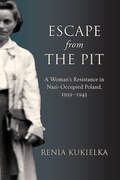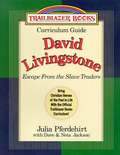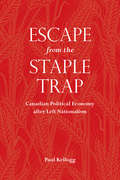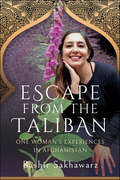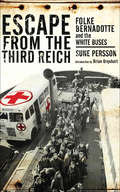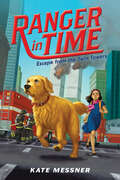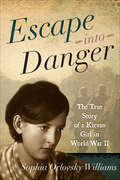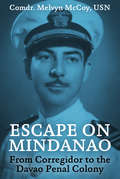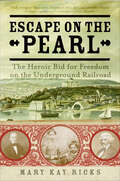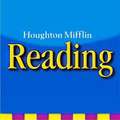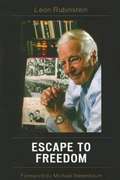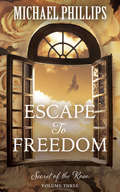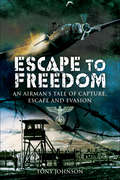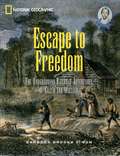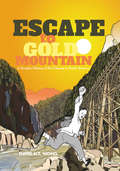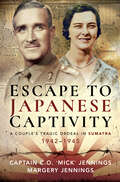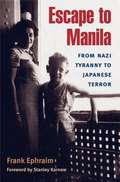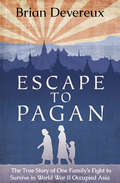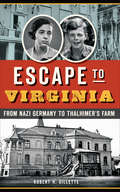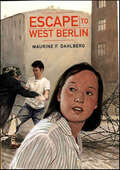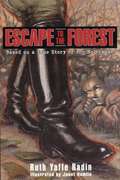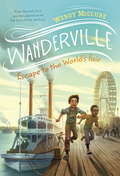- Table View
- List View
Escape from the Pit: A Woman’s Resistance in Nazi-Occupied Poland, 1939–1943 (Excelsior Editions)
by Renia KukielkaAt the end of 1944, while World War II was still raging, nineteen-year-old Renia Kukielka published her Hebrew language memoir about the Holocaust. The account may well be the first of its kind. In her powerful and raw story, she portrays life in the ghettos and her three years of wandering in disguise as a Polish Catholic, trying to escape from the German onslaught. She also recounts how she served for almost a year as a courier between ghettos for the Zionist youth movement's underground cell in Bendzin, carrying weapons, money, and messages, until she was arrested by the Gestapo in 1943. She was tortured in a high-security prison, but, after a daring escape, she was able to flee to British Mandate Palestine with other members of the resistance.Kukielka's memoir manages to combine both immediacy and hindsight. It stands out for its descriptions of life and activities outside of the ghettos and concentration camps in wartime Poland and for its focus on Zionist youth resistance to the Holocaust. It also provides a somewhat rare female perspective on the Holocaust and offers insight into how much was known about the scale of the Nazi atrocities during the war. Following the book's initial publication in Hebrew in 1944, an unauthorized English-language edition was published in the United States in 1947. The present expanded text includes a scholarly introduction, notes, and a historical afterword, which help to explain and contextualize Kukielka's personal account.Published in association with the United States Holocaust Memorial Museum.
Escape from the Slave Traders
by Dave Jackson Neta JacksonDesigned with homeschoolers and Christian educators in mind, each curriculum guide offers a Christian humanities approach to studying one Trailblazer Book and its Christian hero.
Escape from the Staple Trap
by Paul KelloggFrom fur and fish to oil and minerals, Canadian development has often been understood through its relationship to export staples. This understanding, argues Paul Kellogg, has led many political economists to assume that Canadian economic development has followed a path similar to those of staple-exporting economies in the Global South, ignoring a more fundamental fact: as an advanced capitalist economy, Canada sits in the core of the world system, not on the periphery or semi-periphery.In Escape from the Staple Trap, Kellogg challenges statistical and historical analyses that present Canada as weak and disempowered, lacking sovereignty and economic independence. A powerful critique of the dominant trend in Canadian political economy since the 1970s, Escape from the Staple Trap offers an important new framework for understanding the distinctive features of Canadian political economy.
Escape from the Taliban: One Woman’s Experiences in Afghanistan
by Bashir SakhawarzA rare first hand account of the US withdrawal from Kabul through the eyes of a civilian. Deeba first left Afghanistan in 2002, fleeing a war torn country and an abusive husband shortly after she was captured by the Taliban and nearly sold to an Arab Shaikh narrowly escaping due to a small twist of fate. In June 2021, Deeba returned to visit family in Kabul to organize the engagement of her son. Regardless of the Taliban's progress she felt safe to travel after reassurances from the Aghan and US Government's that the Taliban would not be able to take major cities. One morning, to her surprise, she awoke to the news that President Ghani had escaped and Kabul was in the hands of the Taliban, what ensued was a desperate rush to leave the city to return to the USA enduring bomb blasts and crushing crowds at the airport. This is a harrowing account of one woman caught in the US withdrawal of Kabul giving a first hand account of what it was like to be a civilian caught up in the chaos as well as giving an invaluable insight in to the life of a woman in Afghanistan.
Escape from the Third Reich: Folke Bernadotte and the White Buses
by Sune PerssonThe true story of a risky Swedish mission to liberate thousands of prisoners from the Nazis. The Swedish Red Cross expedition to the German concentration camps in March–April 1945 was the largest rescue effort inside Germany during WWII. Sponsored by the Swedish government and led by Count Bernadotte of Wisborg, the mission became known for its distinctive buses. Each bus was purposely painted entirely white, except for the Red Cross emblem on the side, so that they would not be mistaken for military targets. Due to the chaotic conditions during the last weeks of the war, it is impossible to say exactly how many prisoners were liberated by the expedition, but according to conservative figures, by May 4, 1945, at least 17,000 had been transported to Sweden by the so-called White Buses. Of these, some 8,000 were Danes and Norwegians, around 6,000 were Poles, and more than 2,000 were French citizens. This is the first book to tell the full story of this remarkable and hazardous operation. It also details Bernadotte&’s harrowing expedition to Ravensbrück concentration camp and his extraordinary negotiations with Heinrich Himmler, the Reichsführer-SS who was in charge of the German concentration camps, and tells how, during the course of these discussions, Himmler also made an offer of German surrender—an offer that was rejected by the Allies. Includes never before published photographs
Escape from the Twin Towers (Ranger in Time #11)
by Kate MessnerRanger, the time-traveling golden retriever with search-and-rescue training, travels to New York City on the morning of the 9/11 attacks.COURAGE IN THE FACE OF DANGER!Ranger has never needed his search-and-rescue training more than when he arrives at the World Trade Center on September 11, 2001. There he meets Risha Scott and her friend Max who have come to work with Risha's mother for a school project. But when the unthinkable happens and the building is evacuated, Risha is separated from her mom. Can Ranger lead Risha to safety and help reunite her family?
Escape into Danger: The True Story of a Kievan Girl in World War II
by Sophia Orlosvky WilliamsThis WWII memoir tells the remarkable story of a Ukrainian girl&’s perilous adventures and coming of age amid the chaos of war. Born in Kiev to a Catholic mother and a Jewish father, Sophia Williams chose to be identified as Jewish when she became eligible for a Soviet passport at age sixteen. She had no way of realizing the life-changing consequences of her decision. When Germany invaded Russia the following year, Sophia left Kiev and embarked on daring journey into Russia—surviving floods, dodging fires and bombs, and falling in love. After reaching Stalingrad, Sophia found herself stranded in a Nazi-occupied town. She was safely employed by a sympathetic German officer until a local girl recognized her as a Jew. Within days, Sophia&’s boss spirited her to safety with his family in Poland. Soon, though, Sophia was on the run again, this time to Nazi Germany, where she somehow escaped detection through the rest of the war. Her story of survival continues into the postwar years, through starting a family and business with a German soldier. But when her marriage deteriorated, even divorce was not enough to keep her vindictive and violent husband away. Throughout this difficult life, Sophia maintained the grit, charm, and optimism that saved her time and again as she made her &“escape into danger.&”
Escape on Mindanao
by Lt.-Comm. Melvyn H. McCoyEscape on Mindanao is U.S. Navy Lieutenant Commander Melvyn H McCoy's account of his wartime experiences in the Philippines: the defense and fall of Corregidor Island, the Bataan Death March, his internment in Camp Cabanatuan, his transfer to Bilibid Prison in Manila, and finally being sent to the Davao Penal Colony on Mindanao. From the Davao camp, McCoy escaped and led nine other servicemen and two Filipinos on a hazardous journey to a rendezvous with an American submarine which would take them to freedom and safety in Australia. His daily log provides an insight into the dangers the escapees faced, the difficulties in travelling in the jungles and swamps of Mindanao, harrowing encounters with Japanese patrols, and heartwarming accounts of the generosity and assistance of Filipino citizens and guerrillas along the way.For his service, McCoy was awarded the Distinguished Service Cross. The commendation read as follows: The President of the United States of America, authorized by Act of Congress, July 9, 1918, takes pleasure in presenting the Distinguished Service Cross to Commander [then Lieutenant Commander] Melvyn Harvey McCoy, United States Navy, for extraordinary heroism in action in the Philippine Islands, from 4 April to 9 July 1943. After eleven months as a Prisoner of War, and in weakened physical condition, Commander McCoy outwitted the Japanese guards on 4 April 1943, escaped from a prison camp, eluding pursuing patrols, and made his way on foot and by small boat from the vicinity of Davao to northern Mindanao. Hearing of a United States force in Misamis Occidental he contrived to reach its headquarters on foot and by launch. Arrangements for his evacuation having been made, he continued on foot through enemy-occupied territory. By using mountain trails, he avoided capture by numerous Japanese patrols and arrived at the rendezvous. Commander McCoy's courage in the face of great danger and his fortitude despite his physical weakness enabled him to escape and to rejoin the United States forces with information of great military value.
Escape on the Pearl: The Heroic Bid for Freedom on the Underground Railroad
by Mary Kay RicksOn the evening of April 15, 1848, nearly eighty enslaved Americans attempted one of history's most audacious escapes. Setting sail from Washington, D.C., on a schooner named the Pearl, the fugitives began a daring 225-mile journey to freedom in the North—and put in motion a furiously fought battle over slavery in America that would consume Congress, the streets of the capital, and the White House itself.Mary Kay Ricks's unforgettable chronicle brings to life the Underground Railroad's largest escape attempt, the seemingly immutable politics of slavery, and the individuals who struggled to end it. Escape on the Pearl reveals the incredible odyssey of those who were onboard, including the remarkable lives of fugitives Mary and Emily Edmonson, the two sisters at the heart of this true story of courage and determination.
Escape to Canada (Houghton Mifflin Harcourt Vocabulary Readers #Leveled Reader: Level: 5, Theme: 3.2)
by Rob AregoA story of a family's journey from America to Canada during the American Revolution.
Escape to Florence: A Novel
by Kat Devereaux"A powerful debut. . . . This richly textured, well-researched novel is about two women whose lives are inextricably intertwined – one a young Italian resistance fighter during WWII, and the other, a woman fleeing her abusive marriage, inspired by her grandmother’s last wish. This moving page-turner is a love letter to Florence - past and present - and filled with all the juicy elements that hist-fic lovers will celebrate: love, passion, history, courage, secrets and second chances." — Lisa Barr, New York Times bestselling author of Woman on FireMoving between the Second World War and the present, an exhilarating debut novel in the vein of Jennifer Robson, Kate Quinn, and Natasha Lester, about two women, decades apart, whose fates converge in Florence, Italy.Only fourteen, Stella Infuriati is the youngest member of her town’s resistance network during World War II. Risking torture and death, she relays messages, supplies, and weapons to partisan groups in the Tuscan hills. Her parents have no idea, consumed instead by love and fear for their beloved son, Achille, a courier and unofficial mechanic for a communist partisan brigade.Then, after 1945, Stella seemingly vanishes from the records. Her name and story are overshadowed by the tragic death of her brother—until a young writer arrives in Tuscany in the spring of 2019, uncovering long-buried secrets.Fleeing an emotionally abusive marriage and a lonely life on an isolated estate, Tori MacNair has come to Florence, the beautiful city her grandmother taught her to love, to build a new life. As she digs into her family history with the help of Marco, a handsome lawyer, Tori starts to uncover secrets of the past—truths that stretch back decades, to a young woman who risked everything to save her world . . .
Escape to Freedom
by Leon RubinsteinAs a ten-year-old child, Leon Rubinstein fled Germany with his parents in 1933, to Luxembourg and then Belgium, which they fled again on the morning of the Nazi invasion. They dwelt quietly as refugees in the south of France until the Vichy government began its roundup of foreign Jews for deportation. After his father's arrest, Leon endeavors to save himself and his mother with a daring journey to the border towns of southeastern France. Disguising their identities, they hitch a ride with German officers. Along the way, courageous French men and women, including a priest, help them cross the Alps into neutral Switzerland. This memoir gives a rare look at the lives of Jewish refugees in Switzerland-the Swiss work camps where Rubinstein toils along with other male refugees; his stint as a teacher at a home for orphaned Jewish children; his rescue by the Red Cross with a scholarship that enables him to complete his education. He also encounters his first great love at the University of Basel, the beautiful Vera, a child of parents lost in the Holocaust. Vera is a passionate Zionist who is determined to make her way to Palestine in the last months of the British mandate. Throughout this deeply felt story is Rubinstein's awareness of his transformation from adolescence to young manhood amid the catastrophic losses and disloca¬tions of the war years in Europe. His personal story resonates with anyone who remembers discovering love, as well as the necessity of choices and sacrifices. Leon Rubinstein studied at the University of Basel where he earned a teaching degree. After the war, he immigrated to the United States where he switched to the business world and had a successful career with a national company. For the past twenty years, he has written op-ed pieces for Florida newspapers and spoken to students throughout the Florida school system about the Holocaust and his own remarkable story of survival. He and his wife live in Jupiter, Florida.
Escape to Freedom (Secret of the Rose #3)
by Michael PhillipsA dramatic escape from the Iron Curtain tests the convictions of a father and daughter on the run in the Secret of the Rose series. Aided by her one-time love, the American Matthew McCallum, Sabina von Dortmann has succeeded in rescuing her father from a Russian prison where he was held by the Nazis for many years. But now Matthew and the von Dortmanns must begin the far more challenging task of escaping the Iron Curtain and eluding the Communist authorities. Once important members of an underground network dedicated to helping Jews escape the Nazi death camps, the von Dortmanns themselves must now rely on strangers in a hostile country—as well as their unwavering faith in God—to find their freedom.
Escape to Freedom: An Airman's Tale of Capture, Escape and Evasion (Wwii Ser.)
by Tony JohnsonA firsthand account of a World War II crewman in the 427 (Lion) Squadron of the Royal Canadian Air Force who was captured by the Nazis and became a POW.On his third operational mission, Tony Johnson was shot down in his Wellington bomber. Captured shortly after, he was interrogated in Dulag Luft before being sent to Stalag Luft 1 on the Baltic where he stayed from April to September 1944. As the noose tightened on Germany, Tony and his fellow kriegies were kept on the move. He describes the increasingly harsh conditions they all endured, including the infamous Long March of the winter of 1945. He twice escaped, the second time successfully, reaching the Allied Second Army.
Escape to Freedom: The Underground Railroad Adventures of Callie and William
by Barbara Brooks SimonThe year is 1858, and a 14-year old house servant named Callie and another young slave named William attempt a daring escape on the Underground Railroad. Traveling by night, these brave teens come across things they cannot believe, such as an African-American newspaper published by escaped slave Frederick Douglass, all the while amazingly avoiding capture. Barbara Brooks weaves fact-based oral histories of the fictional characters Callie and William with rich period photographs, maps, and/or illustrations on every page, that place the adventures squarely within the era.
Escape to Gold Mountain
by David H.T. WongThis is a vivid graphic history of the Chinese experience in North America over the last 150 years, beginning with the immigration of Chinese to "Gold Mountain" (the Chinese colloquialism for North America) in the 1800s that resulted in decades of discrimination, subjugation, and separation from loved ones. Based on historical documents and interviews with elders, the book is also the epic story of the Wong family as they traverse these challenges with hope and determination, creating an immigrant's legacy in their new home of North America.David H.T. Wong is an architect and historian.
Escape to Japanese Captivity: A Couple's Tragic Ordeal in Sumatra, 1942–1945
by Captain C.O. Mick Jennings Margery JenningsThis harrowing WWII memoir recounts the tragic ordeal of a British couple separated by war and taken prisoner by Japanese forces in Sumatra.Captain C.O. “Mick” Jennings and his wife Margery were living in British Singapore when the Japanese invaded in 1941. Margery was on her way to Australia with other British families when their ship was bombed, leading to her capture in Sumatra. When Singapore fell in February 1942, Mick and other soldiers commandeered a junk and sailed to Sumatra. With a fellow soldier, he set sail for Australia in a seventeen-foot dinghy. But after an appalling ordeal at sea, he was also captured.Despite their close proximity, Mick and Margery never saw each other again. Though they managed to exchange a few letters, Margery died of deprivation and exhaustion in May 1945, shortly before VJ day, while Mick miraculously survived.Based on personal accounts and Margery’s secret diary, this outstanding book describes in graphic detail their attempted escapes and horrific imprisonments. Above all it is a moving testimony to the couple’s courage, resilience, and ingenuity.
Escape to Love
by Denise RobinsStorm Castle - home of the Trevarwiths - on the wild Cornish coast. A bride and bridegroom driving up to the doors...a white-faced child peering from a turret window... the first dread meeting between the bride and her red-haired vixen of a step-mother...In later years, after the death of Celia Trevarwith's father, during the Second World War, Paul Manton comes to the district. A Free-French fisherman; he falls madly in love with Celia. She then embarks on a passionate struggle for her love and happiness with Paul, always up against her step-mother's opposition.
Escape to Love
by Denise RobinsStorm Castle - home of the Trevarwiths - on the wild Cornish coast. A bride and bridegroom driving up to the doors...a white-faced child peering from a turret window... the first dread meeting between the bride and her red-haired vixen of a step-mother...In later years, after the death of Celia Trevarwith's father, during the Second World War, Paul Manton comes to the district. A Free-French fisherman; he falls madly in love with Celia. She then embarks on a passionate struggle for her love and happiness with Paul, always up against her step-mother's opposition.
Escape to Manila: From Nazi Tyranny to Japanese Terror
by Frank EphraimWith the rise of Nazism in the 1930s more than a thousand European Jews sought refuge in the Philippines, joining the small Jewish population of Manila. When the Japanese invaded the islands in 1941, the peaceful existence of the barely settled Jews filled with the kinds of uncertainties and oppression they thought they had left behind. Escape to Manila gathers the testimonies of thirty-six refugees, who describe the difficult journey to Manila, the lives they built there, and the events surrounding the Japanese invasion. Combining these accounts with historical and archival records, Manila newspapers, and U.S. government documents, Frank Ephraim constructs a detailed account of this little-known chapter of world history.
Escape to Pagan: The True Story of One Family's Fight to Survive in World War II Occupied Asia
by Brian DevereuxThe true story of a soldier who survived Japanese capture, a sinking hell ship, and the bombing of Nagasaki, all while his family fought their own battle in the Burmese jungle. While leading an attack on Hong Kong&’s Golden Hill, Jack Devereux of the Royal Scots is shot through the head. Then a Japanese officer attempts to behead him in order to blood his samurai sword. Waking briefly, Devereux kills his would-be executioner, impressing his captors. Fascinated by their prisoner&’s grisly wounds, they allow him to live, but Devereux&’s trials are only beginning. In a precarious physical state, the wounded soldier experiences the horrific sinking of the Japanese freighter LisbonMaru, in which hundreds of POWs drown; survives the shark-infested South China Sea; and burrows in the mines of Nagasaki as the atom bomb falls. Meanwhile, his family hides in Burma, hoping against hope that they will one day be reunited with Devereux. Written by his son, Brian Devereux—whose mother carried him from Mandalay to the deserted medieval city known today as Bagan—this is an amazing account of the terrifying wartime journey of a soldier and his family.
Escape to Virginia: From Nazi Germany to Thalhimer's Farm
by Robert H. Gillette&“Fascinating . . . Provides a history of the Holocaust as the tapestry against which the trials and adventures of these young Jewish youth played out&” (Jewish Book Council). Jewish teenagers Eva and Töpper were desperately searching for an escape from the stranglehold of 1930s Nazi Germany. They studied agriculture at the Gross Breesen Institute in hopes of securing visas to gain freedom from the tyranny around them. Then, Richmond department store owner William B. Thalhimer created a safe haven on a rural Virginia farm where Eva and Töpper would find refuge. Discover the remarkable true story of two young German Jews who endured the emotional torture of their adolescence, journeyed to freedom, and ultimately confronted the evil that could not destroy their spirit. Author Robert H. Gillette retells this harrowing narrative that is sure to inspire generations to come. Includes photos! &“Escape to Virginia is not only an illuminating history lesson, bridging the Old World and the New World during its most tumultuous period, it is also an exemplary story on various levels and for readers of all ages, crystallizing time and again the Gross Breesen spirit of hope, courage and resilience. The book is well researched, vividly narrated, and richly illustrated.&” —Jewish New
Escape to West Berlin
by Maurine F. DahlbergThe advent of the WallHeidi's thirteenth birthday is coming up, but she's disappointed -- her mother is pregnant and refuses to make the annual summer visit to Heidi's grandmother. What's more, it's 1961 and the government is cracking down on border crossers, people who work in the West but live in the East. Heidi's father is a border crosser, and her best friend, Petra, has been forbidden to see Heidi until her father finds a new job in East Berlin. Heidi feels betrayed. Then, as political tension mounts, her parents tell her they are secretly moving West, and Heidi must travel alone to get her grandmother. But how can she do it without Petra's help?The author captures all the terror of the time in her gripping story of an indomitable heroine who steals across the Berlin border by facing her greatest fear.
Escape to the Forest
by Ruth Yaffe RadinWhen the Nazis invade Poland, nothing is safe anymore. Ten-year-old Sarah and her family must leave their home and live in a Jewish ghetto surrounded by barbed wire. There, life is a nightmare of cold and hunger where Nazi soldiers kill Jews at will. But Sarah still hears stories that give her hope-stories about a man who lives in the nearby forest, fighting the Nazis and sheltering other Jews, Sarah's brother thinks they should try to escape to the forest. Her parents think they will be safer where they are, Sarah doesn't know who is right. But as life in the ghetto grows worse and worse, the forest may be their only hope. Based on a true story of life during the Holocaust, this is a heartrending novel of one family's struggle to survive.
Escape to the World's Fair
by Wendy McclureCatch a ferry to the 1904 World's Fair with the orphans of Wanderville! The orphans of Wanderville have decided to never again let themselves be confused by adults offering them shiny red apples and warm beds. They're going to make their way to California and establish a more permanent spot for Wanderville.But when they're suddenly left without means of transportation, the orphans must find a new way of getting to their "town." Enter a dandy motorist with a proposition: If the orphans agree to take a mysterious artifact to the 1904 St. Louis World's Fair on his behalf, they will receive a handsome reward that will allow them to book passage west.The citizens of Wanderville conclude that this is their best bet. What they don't realize, however, is just how treacherous the journey to the fair will be and how much they will need to sacrifice to finally find themselves a new home.
